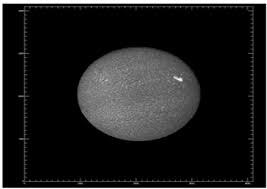
Space weather, influenced predominantly by solar activity, plays a crucial role in affecting satellite operations, communications, and even power grids on Earth. The solar cycle, an approximately 11-year cycle of solar activity characterized by varying levels of solar radiation and sunspot numbers, is a key determinant of space weather. Accurately predicting the amplitude of solar cycles has significant implications for space weather forecasting. Recently, scientists have developed a new method to forecast the amplitude of upcoming solar cycles with greater precision, marking a significant advancement in our ability to predict space weather and mitigate its impacts. This article delves into the details of this new predictive method, its implications for space weather forecasting, and its potential benefits.
Table of Contents
#### **1. Understanding the Solar Cycle**
**a. The Solar Cycle:**
The solar cycle is an approximately 11-year cycle of solar activity that includes variations in the number of sunspots, solar flares, and coronal mass ejections (CMEs). The cycle is divided into two main phases:
– **Solar Minimum:** A period of low solar activity characterized by a minimal number of sunspots and reduced solar radiation.
– **Solar Maximum:** A period of high solar activity with an increased number of sunspots, more frequent solar flares, and heightened solar radiation.
The solar cycle affects space weather, influencing the Earth’s magnetosphere and ionosphere, which can impact satellite operations, communication systems, and power grids.
**b. Importance of Predicting Solar Cycle Amplitude:**
Accurately forecasting the amplitude of the solar cycle—the peak level of solar activity—is crucial for several reasons:
– **Space Weather Forecasting:** The amplitude of the solar cycle impacts the frequency and intensity of space weather events, including geomagnetic storms and solar energetic particle (SEP) events.
– **Satellite Operations:** Understanding solar activity levels helps in predicting potential impacts on satellite systems, including communication and navigation satellites.
– **Infrastructure Protection:** Accurate predictions can aid in protecting power grids and other critical infrastructure from the effects of solar storms.
#### **2. The New Predictive Method**
**a. Overview of the New Method:**
The new method for predicting the amplitude of the upcoming solar cycle involves a combination of advanced statistical techniques and solar observations. This method improves upon previous forecasting models by integrating multiple data sources and using sophisticated algorithms to enhance predictive accuracy.
**b. Key Components of the Method:**
– **Historical Data Analysis:** The method utilizes extensive historical data on solar activity, including sunspot numbers, solar radiation levels, and previous solar cycles. By analyzing patterns and correlations in this data, researchers can identify trends that help predict future cycles.
– **Solar Magnetic Field Data:** Observations of the solar magnetic field, including magnetic field strength and distribution, are incorporated into the predictive model. The magnetic field plays a significant role in solar activity and can provide valuable insights into upcoming cycles.
– **Machine Learning Algorithms:** Machine learning techniques are employed to analyze complex patterns in the data and generate predictions. These algorithms can identify subtle trends and interactions that may not be apparent through traditional methods.
**c. Validation and Testing:**
The new method has undergone rigorous validation and testing using historical solar cycle data and observations. The results have demonstrated improved accuracy in forecasting the amplitude of solar cycles compared to previous models. This validation process ensures that the method can reliably predict future solar activity and contribute to more accurate space weather forecasts.
#### **3. Implications for Space Weather Forecasting**
**a. Improved Forecasting Accuracy:**
The enhanced accuracy of the new predictive method has significant implications for space weather forecasting. Accurate predictions of solar cycle amplitude enable better anticipation of solar activity, leading to more reliable space weather forecasts. This is crucial for:
– **Early Warning Systems:** Improved forecasts allow for timely warnings of potential space weather events, giving organizations and individuals time to prepare and take protective measures.
– **Mitigation Strategies:** Accurate predictions help in developing effective mitigation strategies to protect satellites, power grids, and communication systems from the impacts of solar storms.
**b. Impact on Satellite Operations:**
Satellites are particularly vulnerable to space weather events, which can affect their electronics, communication systems, and orbital paths. With better predictions of solar activity, satellite operators can:
– **Adjust Satellite Operations:** Make adjustments to satellite operations to minimize the impact of solar storms, such as temporarily shutting down sensitive instruments or altering satellite orbits.
– **Enhance Resilience:** Implement measures to enhance the resilience of satellite systems to space weather impacts, reducing the risk of damage and service disruptions.
**c. Power Grid Protection:**
Solar storms can induce geomagnetic currents that affect power grids, leading to potential disruptions and damage. Improved forecasts enable:
– **Grid Operators:** To take precautionary measures, such as reducing load or implementing protective systems to minimize the impact of space weather events.
– **Infrastructure Design:** To design and implement infrastructure that is more resilient to the effects of geomagnetic storms, reducing the risk of widespread power outages.
#### **4. Future Prospects and Research**
**a. Ongoing Research:**
The development of the new predictive method represents a significant advancement, but ongoing research is essential to further refine and improve forecasting models. Areas of focus include:
– **Integration of New Data Sources:** Incorporating additional data sources, such as observations from new solar missions and advanced space weather instruments, to enhance predictive capabilities.
– **Refinement of Algorithms:** Continual refinement of machine learning algorithms and statistical techniques to improve accuracy and reliability.
**b. Collaborative Efforts:**
Collaboration between international space agencies, research institutions, and space weather organizations is crucial for advancing predictive methods and improving space weather forecasting. Shared data, resources, and expertise contribute to more comprehensive and accurate predictions.








